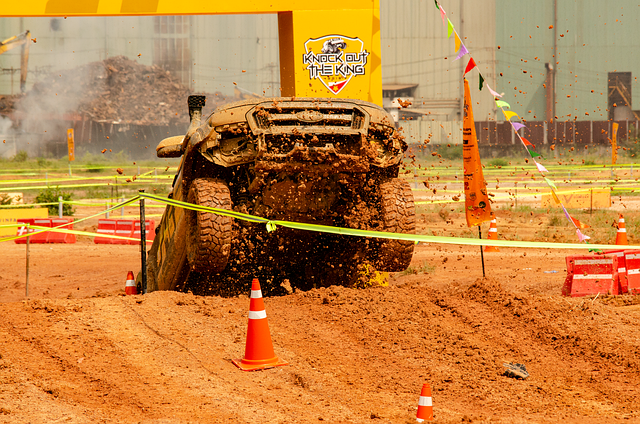Brake pads, essential for RGV's overland 4×4 parts, come in ceramic, metallic, and organic types, each with unique benefits. Durable ceramic pads excel on rough terrain while providing low dust emission; metallic pads offer strong stopping power but may generate more wear particles; organic pads balance these. Choosing the right type depends on driving style and conditions, ensuring optimal performance and safety during off-road adventures. Regular maintenance is crucial, inspecting pads for wear and cracking, with high-quality RGV parts offering superior durability at a higher cost.
“In the world of overland 4×4-parts-RGV, reliable braking systems are paramount for safety and performance. This comprehensive guide delves into the essentials of brake pad replacement and upgrading. We’ll explore different types of brake pads and their functions, unraveling the common signs that indicate a need for replacement.
From understanding the benefits to choosing the right pads for improved performance, we’ll provide expert tips and cost considerations. By the end, you’ll be equipped with the knowledge to navigate this crucial maintenance task effectively.”
- Understanding Brake Pads: Types and Their Functions in Overland 4×4-Parts-RGV
- Why Replace Brake Pads: Common Signs and Benefits for Your Vehicle
- The Upgrading Process: Choosing the Right Brake Pads for Improved Performance
- Maintenance Tips and Cost Considerations for Effective Brake Pad Replacement
Understanding Brake Pads: Types and Their Functions in Overland 4×4-Parts-RGV
Brake pads are an essential component in any vehicle’s braking system, and their role is particularly critical in overlanding and 4×4 vehicles like those from RGV. These pads come in various types, each designed for specific performance needs. The most common types include ceramic, metallic, and organic materials, each with unique advantages and considerations.
In overland adventures, where rough terrain and extreme conditions are frequent companions, durable and high-performance brake pads become indispensable. Ceramic pads, known for their heat resistance and low dust emission, offer smooth braking even under intense use. Metallic pads, on the other hand, provide robust stopping power in challenging environments, though they may generate more wear particles and noise. Organic pads strike a balance between these extremes, offering good all-around performance and comfort. Choosing the right brake pad type for your RGV 4×4 parts depends on factors like driving style, terrain frequency, and desired braking characteristics.
Why Replace Brake Pads: Common Signs and Benefits for Your Vehicle
Brake pads are a vital component in your vehicle’s braking system, responsible for slowing or stopping its wheels. Over time, these pads wear down due to friction and constant use, which can lead to decreased braking performance. This is when it becomes crucial to replace them, ensuring optimal safety while driving.
Common signs indicating that your brake pads need replacing include strange noises during braking (e.g., squealing or grinding), vibration or pulling to one side when applying the brakes, increased braking distance, and visible wear or damage on the pad surface. Upgrading to new brake pads offers several benefits for your vehicle, especially in rugged off-road conditions, as seen with overland 4×4 parts like RGV components. Improved stopping power enhances control during steep descents or sudden manouevres, while reduced braking distances can significantly improve overall driving safety.
The Upgrading Process: Choosing the Right Brake Pads for Improved Performance
When upgrading brake pads, choosing the right ones is paramount for improved performance, especially for those who enjoy off-road adventures with their overland 4×4-parts-RGV. The market offers a wide array of options tailored to various driving styles and vehicle types. For enthusiasts seeking enhanced stopping power on rugged terrain, high-performance ceramic or metal pads can be ideal. These materials offer superior heat dissipation, ensuring consistent braking effectiveness during intense off-road drives.
Additionally, considering the specific requirements of your RGV model is crucial. Different vehicles may have unique brake caliper designs and spacing, dictating the compatibility of brake pads. Referring to the vehicle’s manual or consulting with experts at reliable overland 4×4 parts suppliers can help ensure you select the correct pads for optimal performance and safety during your next adventure.
Maintenance Tips and Cost Considerations for Effective Brake Pad Replacement
When it comes to brake pad replacement, regular maintenance is key for effective performance and safety, especially in demanding off-road conditions like those encountered by overland 4×4 enthusiasts. It’s recommended to inspect pads regularly, checking for wear, cracking, or thinning. This proactive approach allows for timely replacement, ensuring your brakes remain potent when navigating rugged terrains.
Cost considerations play a significant role in the decision-making process. Brake pad upgrades can vary widely depending on the brand and material used. For those looking to enhance their overland 4×4 experience with RGV parts, investing in high-quality pads designed for off-road use is advisable. While these may come at a higher price point, they offer superior durability and performance, ensuring your vehicle stops securely during intense adventures.
Brake pad replacement and upgrading, as highlighted in this article, is a crucial aspect of vehicle maintenance, especially for those venturing into overlands with their 4x4s using RGV parts. By understanding the types, functions, and benefits of different brake pads, you can enhance your vehicle’s performance and safety. The process involves choosing the right pads that match your driving style and terrain, ensuring optimal braking power without compromising comfort. Remember to consider maintenance tips and cost estimates for a seamless replacement experience, keeping your overland adventures smooth and secure.
